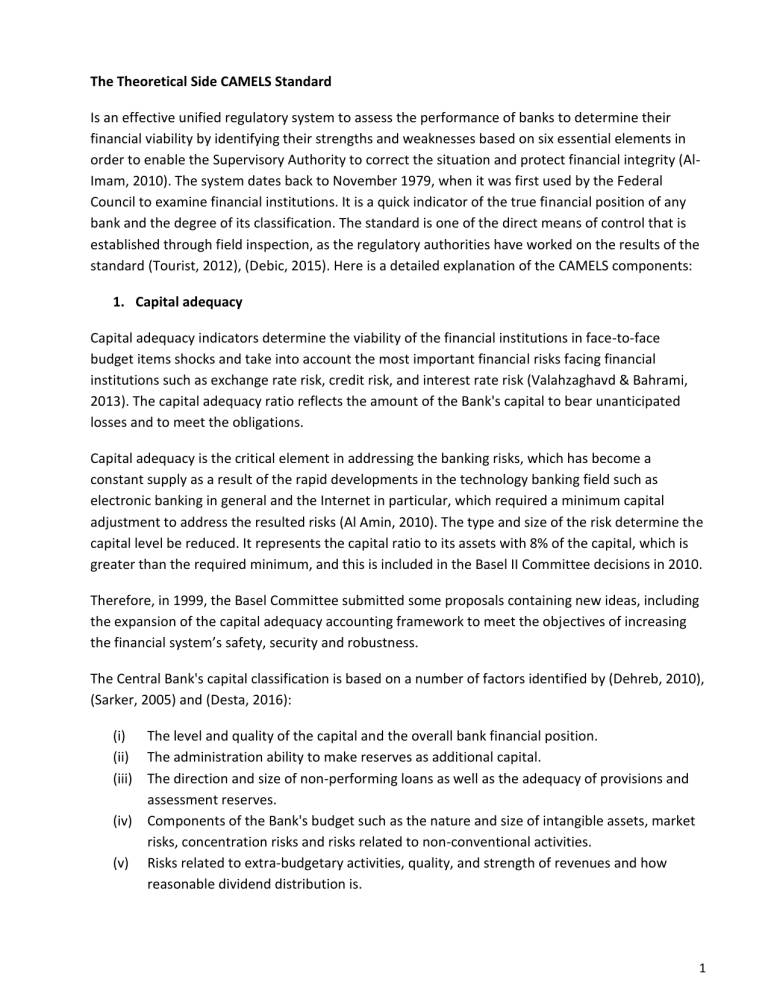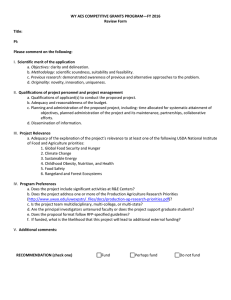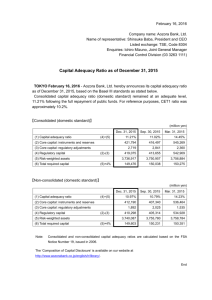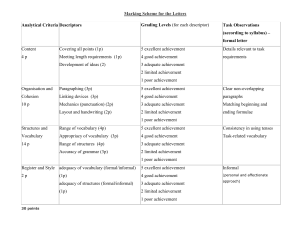
The Theoretical Side CAMELS Standard Is an effective unified regulatory system to assess the performance of banks to determine their financial viability by identifying their strengths and weaknesses based on six essential elements in order to enable the Supervisory Authority to correct the situation and protect financial integrity (AlImam, 2010). The system dates back to November 1979, when it was first used by the Federal Council to examine financial institutions. It is a quick indicator of the true financial position of any bank and the degree of its classification. The standard is one of the direct means of control that is established through field inspection, as the regulatory authorities have worked on the results of the standard (Tourist, 2012), (Debic, 2015). Here is a detailed explanation of the CAMELS components: 1. Capital adequacy Capital adequacy indicators determine the viability of the financial institutions in face-to-face budget items shocks and take into account the most important financial risks facing financial institutions such as exchange rate risk, credit risk, and interest rate risk (Valahzaghavd & Bahrami, 2013). The capital adequacy ratio reflects the amount of the Bank's capital to bear unanticipated losses and to meet the obligations. Capital adequacy is the critical element in addressing the banking risks, which has become a constant supply as a result of the rapid developments in the technology banking field such as electronic banking in general and the Internet in particular, which required a minimum capital adjustment to address the resulted risks (Al Amin, 2010). The type and size of the risk determine the capital level be reduced. It represents the capital ratio to its assets with 8% of the capital, which is greater than the required minimum, and this is included in the Basel II Committee decisions in 2010. Therefore, in 1999, the Basel Committee submitted some proposals containing new ideas, including the expansion of the capital adequacy accounting framework to meet the objectives of increasing the financial system’s safety, security and robustness. The Central Bank's capital classification is based on a number of factors identified by (Dehreb, 2010), (Sarker, 2005) and (Desta, 2016): (i) The level and quality of the capital and the overall bank financial position. (ii) The administration ability to make reserves as additional capital. (iii) The direction and size of non-performing loans as well as the adequacy of provisions and assessment reserves. (iv) Components of the Bank's budget such as the nature and size of intangible assets, market risks, concentration risks and risks related to non-conventional activities. (v) Risks related to extra-budgetary activities, quality, and strength of revenues and how reasonable dividend distribution is. 1 (vi) The ability to enter capital for financing and other sources of capital, including support from the parent company. (vii) The Bank's future growth. 2. Assets Quality The assets quality means the type, the risks it faces, its ability to generate returns, the ability to recover them in the agreed aggregate, the collateral adequacy given to its liabilities and the absence of rigid or unproductive assets. The asset quality rating gives the level of the financial future risks associated with borrowing as well as Portfolio investment, real estate, and off-balance sheet risk. It also shows the classification of the management's ability to identify, measure and control risks. To asset the assessment, we should take into account the adequacy of the debt allocation and the risks based on the value of the investment such as operational risks, corporate’s image, strategy, change systems. Asset quality is particularly important in the evaluation system because it is a critical part of the bank's activity that runs its operations. However, the Bank's acquisition of good assets will result in more income generation and better valuation of both liquidity and capital (Rahim, 2014) (Shaddady & Moore, 2019). Asset quality is based on the following issues: (i) The size and intensity of troubled assets for total capital. (ii) Size and trends of repayment of overdue loans and actions taken to reschedule them. (iii) Large credit concentrations and the risk of the sole debtor or related debtors. (iv) The volume and treatment of the management of staff loans. (v) Effective loan portfolio management in view of the strategies, policies, procedures, controls, and instructions in force. (vi) Legal activities related to credit (claim, the pursuit of borrowers). (vii) The provisions level made to meet the losses of loans and bad credit. (viii) Methods of managing other assets and investing in securities, second assets, bills of exchange ... etc.) Assets quality also determines the degree of risk in assets and the Bank diversifies into the total loans and geographical areas as well as the investment in securities in order to reduce the risk to which it may be exposed. The bank's acquisition of good assets will generate more profits and better valuation of liquidity, management, and capital (Muralidhara & Lingam, 2017). 2 (Almahmoud, 2014), (Treaa, 2015), (Handorf, 2016) and (Dincer et al, 2018) noted that asset quality rating reflects the size of current and future risks related to lending, investment portfolio, depreciated real estate and extra-budgetary activities. The classification reflects the management's ability to quantify risk control. An asset quality assessment must consider the adequacy of debt provisions, the risks that affect the value of investments such as operational risk, market, strategic capacity, and regime change. An asset quality assessment depends on the following factors: (i) The adequacy of the collateral criteria, the strength of loan management and the relevance of the risk identification. (ii) The distribution level of the severity and direction of the classified scheduled debt and non-operating debt within and outside the budget. (iii) Adequacy of debt and investment allocations or valuation reserves. (iv) Lending risks arising from or low in off-budget operations such as unfunded credit commitments and lending lines. (v) Diversity and quality of loans and investments portfolio. (vi) Undertaking activities related to trading activities. (vii) Policies and procedures for loans and investments. (viii) The management ability to manage the bank's assets, including debt collection. (ix) The adequacy of internal control and information systems. 10. Size and nature of debt documentation. 3. Management Efficiency The ability of the management to control & manage the banking and credit policy on a sound basis measured by several indicators such as profit trends achieved over several financial periods and the financial institution reports on the internal control systems, which reduces the errors incidents of and irregularities and the ability to attract deposits in addition to the adequacy of the Central Bank in placement. As well as follow the bank decisions and controls governing the banking work issued by the monetary authority. There are some quantitative indicators that can be relied upon: Spending rates; Income ratio of each employee; Expanding the preparation of financial institutions. (Zagod, 2015), (Williams, 2011). It reflects the efficiency and ability of the Bank's Board of Directors and its Executive Management in managing risk. Management efficiency will be measured by its ability to control the Bank's operating banks by dividing the Bank's operating expenses on total assets. We consider the administrative performance as an essential component to judge the Bank's success in achieving its objectives through the interaction of many factors related to the tasks and 3 responsibilities assigned to management, the ability to deal with the developments, environmental and banking changes and to achieve the necessary supervision in this regard. The following are the most important issues to be considered. To determine the appropriate classification of management by studying the following factors: (i) Understand the risks inherent in banking, environmental and economic activities. (ii) The financial performance of the bank in view of the quality of the assets, the adequacy of capital, profits, and liquidity. (iii) Develop and implement plans, policies, and controls in all key areas of work. (iv) Power and convenient function and realization of internal and external audit. (v) Adhering to the laws and the in-force regulations of the Central Bank. (vi) Trends towards the bank public interest. (vii) Compliance with the laws and legislation and the interaction between the Board of Directors and the General Assembly of shareholders. (viii) Application of the principles of acquisition of experience and functional skills to take into account career substitution. (ix) Experiences with the concerns and recommendations of the Central Bank and taking into account the accuracy of financial reports and statements. (x) Provide training programs for human resources and attract them effectively and to make sure that it works with high quality. In general, the Board of Directors should not be involved in the Bank’s daily operations, but the Board should provide guidelines for the acceptable risk the level and ensure that appropriate policies, procedures, and practices have been created (Shakara, 2012), (Rozzani &Rahman&Dincer, 2013), (Hacioglu, 2015). The management's ability evaluation shall be based on the following factors: (i) The level and quality of management of the Bank's activities. (ii) The ability of the board of directors and management, each according to its competence, to plan and deal with the risks that may arise from changes in working conditions or providing new activities and products. (iii) The adequacy of the internal control systems to deal with all risks. (iv) Accuracy, timeliness, and effectiveness of information systems and risk control systems. (v) Adequate audit systems and control systems to activate the efficiency of operations. (vi) Experiences with recommendations from auditors and control authorities. (vii) The extent to which the board of directors and management is an outside influence. 4 (viii) Reasonableness of incentive policies and avoidance of individual work. (ix) The extent of the administration's desire to take care of the bank's legal interests and community service. 4. Earnings Earnings are the Bank's ability to consistently generate revenues and profits in a balanced manner, as well as implementing policies that reduce public expenditure and track doubtful debts so as not to falter. It also shows the factors influencing earnings and the lending risk which pushes the Bank to make provisions and risks of the financial market that cause the Bank profits changes as a result of its impact on interest rates. Earnings are affected by relying on undisclosed or unnecessary profits. (AlAmin, 2010) (Al-Qaisi, 2017) (Britch et al, 2013). Earnings achievement is the most important objectives and determinants of the bank performance since profits are the main source for achieving appropriate returns to the bank shareholders. The Bank's management considers profits as an important element to ensure the Bank's continuous performance. It directly affects the strength of the assets and its effectiveness which is measured by determining the return on average assets as the starting point for profit assessment as well as studying and analyzing the following factors: (i) (ii) (iii) (iv) Profit adequacy to meet losses, enhance capital adequacy and pay reasonable dividends. The quality and installation of net income elements including taxes. Size and trends of various elements of net income. The extent of reliance on exceptional items, securities transactions, high-risk activities or nontraditional income sources. (v) Budget effectiveness and control the income and expenditure items. (vi) Provisions adequacy of and loan losses provisions. The Earnings ratio for taxonomic purposes is usually determined based on the lower performance of the banks of similar characteristics. Focusing on them leads to some results. For example: The bank may earn very high profits, but the source of profits may come from a one-off or nontraditional (high-risk) activity. In spite of high Earnings, retention of profits remains insufficient to allow capital growth and maintain a guideline to assets. Earnings reflects the realized profits level of, their contribution to the bank's growth and capital increase (Gilbert et al, 2002). The profit classification should not only reflect its direction but also the profits quality and the factors affecting them such as credit risk and market risk. The Bank's profits may be subject to change as a result of the change in the interest rate. Also, the quality of the profit is affected by nonrecurring profits or tax advantage (Aspal & Dhawan, 2016). 5 The revenue quality can also be affected by reliance on non-recurring profits or on a tax advantage. Earnings can also be affected by the inability to access financing needs, inability to control expenditures or adopting a weak strategy (Rauf, 2016) and (ALreda&Albasry, 2011). Revenue classification is based on the following factors: (i) The revenues level including the direction and stability of revenues. (ii) Ability to consolidate capital accounts through retained earnings. (iii) Quality and revenue sources. (iv) Banks ratio to operations. (v) The budget system adequacy, forecasting processes, and information risk management. (vi) The adequacy of the volume of debt provisions. (vii) Income related to market risks such as interest rate and exchange rate. 5. Liquidity It is the relevance between collecting liquidity as quickly as possible and the best price, and between investing and employing it in a meaningful manner. The bank's liquidity management aims at achieving the following: (i) Making the right decisions regarding the volume of the deposit, which shall reach a certain level as the increasing of the volume of the deposit in the employment absence leads to low earnings. (ii) Maintain adequate liquidity ratios for emergency needs. (iii) Respecting liquidity ratios set by the monetary authority in addition to setting a minimum liquidity limit in line with the Bank's activities (Al-Tayy and Mahmoud, 2013) (Khodashahi et al, 2018). Liquidities are particularly important in assessing the Bank financial adequacy because it reflects the Bank's ability to meet its obligations to creditors, especially depositors. Liquidity will be measured by dividing the liquid assets of the Central Bank on total assets. The bank's liquidity management shall ensure that the bank is able to maintain an adequate level that liquidity is not at the expense of cost or rely on funds sources that may be available in difficult circumstances. Liquidity is the ability of the Bank to meet depositors' withdrawals while meeting the needs of borrowers at the same time without having to sell securities with large losses or borrowing at highinterest rates (Rahman & Islam2018). 6 When assessing the bank's liquidity, it is necessary to focus on the current level of liquidity as well as the future need. Liquidity management shall ensure adequate liquidity to meet different liabilities on perfect time, taking into account the mismatch between the assets and liabilities in the banking sector or at large-sized financial institutions level (al-Tai and Mahmoud, 2013), (Sarker, 2005) (Ghasempour & Salami, 2016). 6. Sensitivity to Market Risk Sensitivity to Market Risk reflects the changes in interest rates, exchange rate, commodity price, and stock prices that may adversely affect the Bank's financial position or capital. In assessing sensitivity, consideration should be given to the management's ability to determine the monitoring and control of these risks, the size of the bank, the complexity of these processes, the adequacy of revenues and capital in relation to the level of these risks. For most banks, the main source of this type of risk is non-trading positions and their sensitivity to interest rate risk in large banks. Foreign banking operations can be a source of market risk. In some banks, trading activities are the main source of market risk, (Rostami, 2015), the most important of which are: 1. Credit risk, 2. Price risk, 3. Liquidity risk Market risks refer to the impact of lower asset prices on the Bank's net worth. The reason for the decline is due to several reasons, the most important of which is the portfolio's concentration in certain types of assets or banks’ tendency to direct their investments to assets with significant activity such as mortgages. The sensitivity to market risk reflects the changes in the interest rate, exchange rate and securities prices that negatively affect the financial position of the bank. In light of the developments and challenges in the financial and banking arena, it is necessary to focus on the sensitivity of the assets structure and liabilities and bank’s net profits to adverse changes in interest rates and exchange rates, (Rahim, 2014), (Drummond, 2000), (Githinji, 2010). 7





